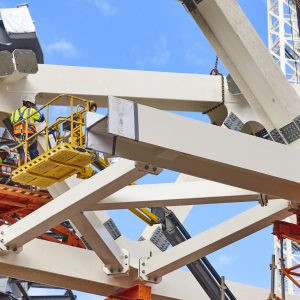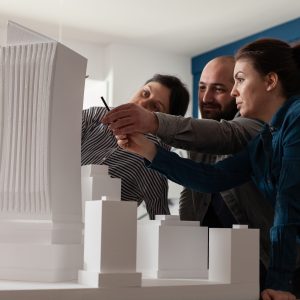 The construction industry remains the largest industry in the world. In fact, its market size is expected to reach $14.4 trillion U.S. dollars in 2030 according to Statista. Behind this success are the pivotal roles of architecture and construction engineering. These industries are not only responsible for designing and building the structures we inhabit. They also find innovative solutions to complex challenges, such as sustainability and urbanization. To keep pace with these evolving demands, the staffing trends in architecture and engineering are constantly shifting too. In this blog, we will take an in-depth look at the current staffing trends in these industries and explore how professionals, firms, and educational institutions are adapting to the changing landscape.
The construction industry remains the largest industry in the world. In fact, its market size is expected to reach $14.4 trillion U.S. dollars in 2030 according to Statista. Behind this success are the pivotal roles of architecture and construction engineering. These industries are not only responsible for designing and building the structures we inhabit. They also find innovative solutions to complex challenges, such as sustainability and urbanization. To keep pace with these evolving demands, the staffing trends in architecture and engineering are constantly shifting too. In this blog, we will take an in-depth look at the current staffing trends in these industries and explore how professionals, firms, and educational institutions are adapting to the changing landscape.
6 Architecture and Construction Engineering Staffing Trends
The Rise of Multidisciplinary Teams
One of the most prominent trends in architecture and construction engineering staffing is the increasing emphasis on multidisciplinary teams. As projects become more complex, there is a growing need for professionals with diverse skill sets to collaborate effectively. Architects, structural engineers, environmental consultants, and urban planners are now working together to create holistic solutions. These solutions address not only aesthetic and structural concerns but also environmental and social impacts.
This shift towards multidisciplinary teams has resulted in greater demand for professionals who can bridge the gap between different fields. Architects with knowledge of sustainable design principles, for instance, are highly sought after. They can integrate green building practices seamlessly into a project’s design.
The Influence of Technology

Technology has always been a driving force in architecture and engineering. Moreover, recent advancements have had a profound impact on staffing trends. Building Information Modeling (BIM) software, for example, has revolutionized the way professionals work together and manage projects. As a result, firms are increasingly looking for candidates who are experts in BIM and other cutting-edge technologies.
Additionally, the rise of artificial intelligence (AI) and machine learning is transforming the way architects and engineers approach design and problem-solving. Professionals who can harness the power of AI to optimize building performance or simulate environmental conditions are becoming increasingly valuable. With BizForce by your side, you’ll work with architectural and engineering professionals who not only embrace AI but also bring innovative solutions to your projects with their software expertise.
Sustainability and Green Design
Sustainability has moved to the forefront of architectural and engineering considerations. There are growing concerns about climate change and resource depletion. Therefore, there is a strong emphasis on designing and constructing environmentally friendly buildings and infrastructure. This has led to a surge in demand for professionals with expertise in sustainable design, energy efficiency, and renewable energy sources.
Engineers who specialize in sustainable infrastructure and architects who incorporate green building principles into their designs are in high demand. Governments and organizations worldwide are setting ambitious sustainability goals. These goals further drive the need for skilled professionals in this area.
Remote Work and Global Collaboration
The COVID-19 pandemic accelerated the adoption of remote work in many industries, including architecture and engineering. While these professions traditionally required physical presence at project sites and in the office, the pandemic demonstrated that remote work can be effective, leading to a shift in staffing practices.
The embrace of remote work not only broadens the availability of skilled professionals but also fosters diversity and inclusion within the architecture and engineering industries. Organizations are now better equipped to tap into a wider range of experiences, skills, and viewpoints. This inclusivity strengthens the industry’s ability to address complex challenges, such as sustainability, by drawing on a more diverse and creative talent pool.
Remote work has also given rise to a new era of global collaboration. Teams are no longer confined to a single office or time zone. Instead, architects, engineers, and other professionals from around the world can seamlessly collaborate on projects, leveraging their combined expertise and diverse cultural backgrounds. This global collaboration can drive innovation by integrating a variety of ideas and approaches, ultimately leading to more creative and effective solutions.
Diversity and Inclusion
Diversity and inclusion have become crucial considerations in architecture and engineering staffing. Increasingly, firms recognize the importance of creating diverse teams that reflect the communities they serve. This includes gender diversity, racial and ethnic diversity, and diversity in terms of backgrounds and experiences.
Efforts to promote diversity and inclusion are not only ethically sound but also benefit firms by fostering creativity and innovation. Many organizations now have diversity and inclusion initiatives in place. They actively seek out candidates from underrepresented groups to join their teams.
Educational Adaptations
As staffing trends evolve, educational institutions are adapting to ensure that graduates are well-prepared for the industry’s changing demands. Curricula are being updated to include courses on sustainability, technology, and interdisciplinary collaboration. Additionally, there is a growing emphasis on hands-on experience and internships to bridge the gap between academic knowledge and practical skills.
Furthermore, online education and certification programs have become more accessible, allowing professionals to upskill and stay current with industry trends without the need for traditional classroom-based education. These educational adaptations are vital for preparing the future workforce of architects and engineers to meet the industry’s evolving demands. Graduates with updated skill sets, practical experience, and access to relevant online education are better positioned to excel in their careers and contribute to innovative solutions in areas such as sustainable design, technology integration, and interdisciplinary collaboration.
Conclusion

The architecture and construction engineering industries are dynamic and continually evolving, driven by technological advancements, sustainability concerns, and a changing workforce. To thrive in this landscape, professionals, building companies, and construction firms must embrace multidisciplinary approaches. They should harness the power of technology, prioritize sustainability, and promote diversity and inclusion.
As we move forward, these staffing trends will continue to shape the way projects are conceived, designed, and executed. Those who adapt and stay at the forefront of these trends will be best positioned to make meaningful contributions to the built environment and tackle the challenges of the future.
Whether you need BIM experts or AI-savvy architects and engineers, BizForce is your trusted partner in navigating the technological advancements that are shaping the future of architecture and engineering. Ready to take your projects to the next level? Let’s collaborate! Contact us here.
